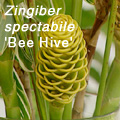Most people are familiar with edible ginger (Zingiber officinale), but it is only one of hundreds of members of the Zingiberaceae, or ginger family. Many are used in the garden rather than the kitchen, and these are called ornamental gingers. This group of plants is perfect if you are trying to achieve that lush, green look in a tropical or Asian-style garden.
Although they are closely related, the gingers belong to different genera, including Alpinia (shell ginger), Globba, Hedychium (butterfly ginger), Kaempferia (peacock ginger), Zingiber and Curcuma. Some species are evergreen, while others lose their leaves in winter. Most gingers have unusual, long-lasting flowers. Gingers differ in their cultural requirements, but generally they like a warm, humid climate, part shade and shelter from cold winds.
In our segment Don looked at some of the fabulous tall-growing gingers, such as Z. spectabile ‘Bee Hive’, which has yellow and white curled floral leaves (or bracts) in a beehive shaped flowerhead, and the spectacular Etlingera elatior ‘Red Torch’. It bears its flowers in a waxy, pyramid-like cone of red bracts and grows to around 2m (6′) high. Z. parishii ‘Lemon Lights’ grows to about 1.5m (5′) and has bright lemon yellow bracts. Blue ginger (Dichorisandra thyrsiflora) is not a true ginger, but it has ginger-like, arching stems and vibrant, purple/blue flowers in autumn.
Some of the common alpinia and zingiber varieties can become too big and leggy for all but large gardens. However, there are smaller growing, non-running gingers called curcumas, which are perfect for pot culture and small gardens.
Curcumas
Curcumas are herbaceous perennials from Indochina, South East Asia, the Pacific Islands and northern Australia. They have broad, veined leaves, and small, brightly coloured flowers which emerge from large bracts. The flowers range in colour from white to pink, orange and shades of violet. The flower spikes last for several weeks. The best known member of the genus is Curcuma longa (also known as C. domestica). Its bright orange rhizomes are used to make the spice turmeric, and for dyeing cloth. Curcumas die down in winter and re-emerge in spring, much like bulbs do.
Varieties featured in our segment:
Curcuma ‘Tropical Snow’ – white flower, 50cm (20″) tall
Curcuma ‘Thai Magic’ – pink flower, 50cm (20″) tall
Curcuma ‘Thai Beauty’ – dark pink flower, 30cm (12″) tall
Curcuma gracillimum ‘Candy Stripe’ – pink flower with dark striped edges, 30cm (12″) tall
Curcuma alismatifolia ‘Siam Tulip’ – pink/mauve flower, 40cm (16″) tall
Curcuma cordata ‘Jewel of Thailand’ – pink flower, 50cm (20″) tall
Growing curcumasMany curcumas are only 30cm (12″) to 1m (3′) tall, so they are suitable for growing in containers. They can be grown in pots outdoors, or as a temporary indoor plant in a well-lit position. When the foliage starts to die back at the beginning of winter, remove the dead leaves and move the pot to a warm, dry place. When new leaves appear in spring, repot into a bigger container and feed with an organic or slow release fertiliser.
Curcumas can also be grown in the garden as far south as Sydney. They like a moist, well-drained soil with protection from wind and direct sun. Bulbs left in the ground during wet winters may rot, so they are best lifted and stored in a warm, dry place, then planted out again in September/October. Fertilise when new shoots appear.
Cost and availability
Small ornamental gingers are readily available in Queensland, Darwin and Perth. However, they may be difficult to find in NSW. The nurseries listed below have them in stock, or they can be ordered through your local garden centre or nursery.
Rast Bros Nursery, 31-37 Kissing Point Road, Turramurra, NSW
Bonnyrigg Garden Centre, cnr Elizabeth Drive and Wilson Road, Bonnyrigg, NSW
Gardens R Us, 75 Gardeners Road, Kingsford, NSW
Expect to pay around $11 for plants in 140mm (6″) pots.
Further information
Our segment was filmed at:
Palmwood Tropicals (wholesale)
Fax: (07) 5445 0015



